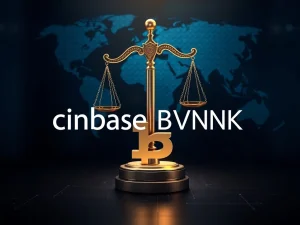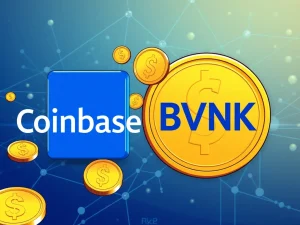Unlocking Japan’s Real Estate: MUFG’s ¥100B Osaka Property Fuels Tokenization Revolution

Are you ready to witness a seismic shift in how real estate is bought and sold? Japan’s financial giant, Mitsubishi UFJ Financial Group (MUFG), is making waves with a monumental acquisition. They’ve just purchased a staggering ¥100 billion (approximately $681 million) high-rise property in Osaka, not just as a traditional investment, but as a flagship asset to spearhead the expansion of Tokenized Real Estate Japan. This isn’t just a big property deal; it’s a strategic move that could redefine property ownership and investment, making it more accessible than ever before.
MUFG’s Bold Move: A ¥100 Billion Bet on Tokenized Real Estate in Japan
MUFG, through its trust banking unit, has acquired a prime Osaka property, signaling a powerful push into the digital securities market. This isn’t a speculative gamble; it’s a calculated strategy to position this landmark building as a cornerstone for tokenized real estate offerings. The plan is to convert this high-rise into a private real estate investment trust (REIT) primarily for institutional players like life insurance firms, while also creating tokenized slices specifically for retail buyers. This dual-track approach aims to bridge the gap between traditional finance and the innovative world of digital assets.
Japan has been a quiet leader in asset tokenization, especially concerning commercial property. Since 2021, the country has seen 63 digital securities issued, totaling ¥194 billion ($1.3 billion), with a remarkable 80% of these involving real estate. MUFG‘s latest acquisition is a clear indicator of this ongoing trend, reinforcing Japan’s focus on tangible assets rather than just digital bonds. It’s a testament to the nation’s methodical yet determined adoption of blockchain technology for asset management.
Unpacking Digital Securities: Fractional Ownership for All
The concept of Digital Securities, particularly in real estate, is all about democratizing access. Imagine owning a piece of a massive commercial building without needing millions of dollars. That’s the power of tokenization. By fractionalizing ownership through digital tokens, MUFG aims to enable retail investors to participate in lucrative real estate markets that were previously exclusive to the ultra-wealthy or large institutions. This lowers the barrier to entry significantly, opening up new investment avenues for a broader audience.
For institutional investors, the private REIT structure offers a familiar and conventional entry point, easing their transition into the digital asset space. This reflects a smart, two-pronged strategy by MUFG: catering to established players with familiar structures while simultaneously innovating to attract new, smaller investors. Here’s a quick look at the benefits of this approach:
- Increased Accessibility: Retail investors can own fractions of high-value properties.
- Enhanced Liquidity: Tokens can potentially be traded more easily than traditional property shares.
- Diversification: Investors can diversify their portfolios with smaller allocations across multiple properties.
- Transparency: Blockchain technology offers a transparent and immutable record of ownership.
The Osaka Property: A Beacon for Japan’s Digital Asset Future
The newly acquired Osaka Property isn’t just another building; it’s set to become a symbol of Japan’s ambitions in the digital asset space. Its conversion into a private REIT with tokenized slices makes it a practical example of how large, illiquid assets can be transformed into more accessible, digital forms. This flagship asset will serve as a real-world test case for the scalability and viability of tokenized real estate in a major economy.
However, it’s important to acknowledge that the market is still in its infancy. The Osaka Digital Exchange’s START market, for instance, currently lists only six real estate tokens, with monthly trade volumes hovering around a modest ¥23 million ($157,000). This low liquidity suggests that while the infrastructure is being built, broader institutional and retail adoption will depend on overcoming operational hurdles and building robust trust in these new digital ownership mechanisms.
Progmat Platform: Powering Japan’s Tokenization Infrastructure
At the heart of MUFG’s tokenization efforts lies Progmat, the bank’s security token platform. This platform is crucial for the issuance and management of digital securities, including the tokenized real estate offerings. Interestingly, the development highlights evolving dynamics between MUFG and Mitsui Digital Asset Management, a key player in the tokenized real estate sector. Mitsui previously partnered with MUFG Trust for legal frameworks but has recently established its own Alterna Trust system to accelerate its offerings independently.
Despite Mitsui’s move to issue 16 tokenized real estate deals independently (with 14 via its Alterna platform), both entities remain connected through Progmat. Mitsui has agreed to continue using Progmat for future projects, ensuring MUFG’s ongoing backend revenue. MUFG’s substantial 42% stake in Progmat means that even with increased competition, the bank continues to monetize the foundational infrastructure of Japan’s digital asset ecosystem. This hybrid strategy of direct competition and strategic collaboration is characteristic of the fragmented yet rapidly growing digital asset landscape in Japan.
Navigating the Landscape: Challenges and Opportunities in Japan’s Tokenized Market
The Tokenized Real Estate Japan market, while promising, faces its share of challenges. Regulatory clarity, though progressing, still lags behind the innovative strides being made by financial institutions. Establishing widely accepted technical frameworks and ensuring robust investor protection are critical for scaling up. Building trust in digital ownership mechanisms is paramount, especially for a market as traditionally conservative as real estate.
However, the opportunities are immense. Fractional ownership can unlock capital from a wider pool of investors, potentially increasing liquidity in traditionally illiquid asset classes. It can also streamline transaction processes, reduce costs, and enhance transparency through blockchain technology. MUFG’s ability to monetize its infrastructure while simultaneously advancing its own tokenization goals will be a key determinant of success in this evolving market. The cautious yet deliberate adoption of blockchain for asset tokenization underscores Japan’s commitment to innovation while maintaining stability.
MUFG’s acquisition of the ¥100 billion Osaka property marks a significant milestone in the evolution of Japan’s financial landscape. It’s a powerful statement about the future of real estate investment, moving towards a more inclusive and efficient model powered by digital securities. While challenges remain in market liquidity and regulatory refinement, this bold move by MUFG, leveraging its Progmat platform, sets a clear precedent. It signals a future where investing in prime commercial properties is no longer just for the few, but for anyone looking to build wealth, one digital token at a time. This initiative is not just about a single property; it’s about building the foundation for a truly revolutionized real estate market in Japan.
Frequently Asked Questions (FAQs)
1. What is tokenized real estate and how does MUFG use it?
Tokenized real estate involves converting traditional property ownership rights into digital tokens on a blockchain. MUFG is using this by acquiring a major Osaka property, then converting it into a private REIT and issuing fractional digital tokens representing ownership stakes. This allows both institutional and retail investors to own a portion of the property.
2. What is the significance of MUFG’s ¥100 billion Osaka property acquisition?
The ¥100 billion Osaka property acquisition is significant because it’s a flagship asset for MUFG’s push into tokenized real estate in Japan. It demonstrates a major financial institution’s commitment to digital securities, serving as a real-world example of how large assets can be fractionalized and made accessible to a broader range of investors, from institutions to retail buyers.
3. How does Progmat fit into Japan’s digital asset ecosystem?
Progmat is MUFG’s security token platform, serving as a foundational infrastructure for issuing and managing digital securities in Japan. It acts as a backend system that facilitates the creation and transfer of tokenized assets, including real estate. Even as other players like Mitsui develop their own systems, Progmat remains a key platform, ensuring MUFG’s continued influence and revenue in the growing digital asset ecosystem.
4. What are the benefits and challenges of fractional ownership in real estate?
Benefits of fractional ownership include increased accessibility for retail investors, potential for enhanced liquidity compared to traditional property, and easier portfolio diversification. Challenges involve the nascent market’s low liquidity, the need for further regulatory clarity, and the ongoing process of building investor trust in digital ownership mechanisms.
5. What is the current state of the tokenized real estate market in Japan?
The tokenized real estate market in Japan is nascent but growing. It has seen significant issuance volume, with real estate accounting for 80% of digital securities issued since 2021. However, market liquidity remains low, as evidenced by modest monthly trade volumes on platforms like the Osaka Digital Exchange. Major players like MUFG and Mitsui are actively developing the market, testing boundaries and refining models for broader adoption.







